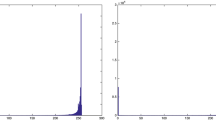Abstract
This paper addresses the problem of motion parameter recovery. A novel paradigm is offered to this problem, which computes a maximum likelihood (ML) estimate. The main novelty is that all domain-range point combinations are considered, as opposed to a single “optimal” combination. While this involves the optimization of nontrivial cost functions, the results are superior to those of the so-called algebraic and geometric methods, especially under the presence of strong noise, or when the measurement points approach a degenerate configuration.
Access this chapter
Tax calculation will be finalised at checkout
Purchases are for personal use only
Preview
Unable to display preview. Download preview PDF.
Similar content being viewed by others
References
A. Adam, E. Rivlin, and I. Shimshoni. Computingthe sensory uncertainty field of a vision-based localization sensor. IEEE Trans. on Robotics and Automation, 17(3):258–267, June 2001.
D. A. Forsyth, S. Ioffe, and J. Haddon. Bayesian structure from motion. In ICCV99, pages 660–665, 1999.
R. Hartley and A. Zisserman. Multiple Views Geoemtry in Computer Vision. Cambridge University Press, 2000.
R. I. Hartley. In defense of the eight-point algorithm. IEEE Trans. Patt. Anal. Mach. Intell., 19(6):580–593, June 1997.
K. Kanatani. Geometric computation for machine vision. In Oxford University Press, 1993.
K. Kanatani. Statistical-analysis of geometric computation. CVGIP, 59(3):286–306, May 1994.
H. C. Longuet-Higgins. A computer algorithm for reconstructing a scene from two projections. Nature, 293:133–135, 1981.
W. Press, B. Flannery, S. Teukolsky, and W. Vetterling. Numerical Recipes in C. Cambridge University Press, 1988.
G. Speyer and M. Werman. Parameter estimates for a pencil of lines: Bounds and estimators. In ECCV, 2002.
P. H. S. Torr and A. Zisserman. Concerning Bayesian motion segmentation, model averaging, matching and the trifocal tensor. In H. Burkharddt and B. Neumann, editors, ECCV98 Vol 1, pages 511–528. Springer, 1998.
M. Werman and D. Keren. A Bayesian method for fittingp arametric and nonparametric models to noisy data. IEEE Trans. Patt. Anal. Mach. Intell., 23(5):528–534, May 2001.
Z. Zhang, R. Deriche, O. Faugeras, and Q. Luong. A robust technique for matching two uncalibrated images through the recovery of unknown epipolar geometry. Artificial Inteligence, 78(1–2):88–119, 1995.
Author information
Authors and Affiliations
Editor information
Editors and Affiliations
Copyright information
© 2003 Springer-Verlag Berlin Heidelberg
About this paper
Cite this paper
Keren, D., Shimshoni, I., Goshen, L., Werman, M. (2003). All Points Considered: A Maximum Likelihood Method for Motion Recovery. In: Asano, T., Klette, R., Ronse, C. (eds) Geometry, Morphology, and Computational Imaging. Lecture Notes in Computer Science, vol 2616. Springer, Berlin, Heidelberg. https://doi.org/10.1007/3-540-36586-9_5
Download citation
DOI: https://doi.org/10.1007/3-540-36586-9_5
Published:
Publisher Name: Springer, Berlin, Heidelberg
Print ISBN: 978-3-540-00916-0
Online ISBN: 978-3-540-36586-0
eBook Packages: Springer Book Archive




